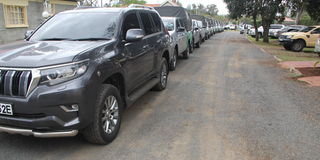Ignore the lies, here is the truth about leasing

Some of the 21 vehicles that have been lying at the compound of Laikipia Governor's office and which were driven back to Toyota Kenya Limited Yard after termination of a five-year-leasing contract.
Never let the truth get in the way of a good story! When a friend told me these words during the campaigns for the last general elections, he meant it as sarcasm, not to be taken literally.
The tongue-in-check comment arose as we talked heatedly about press coverage of the campaign. Is there room for truth, we wondered, as the media relayed various outlandish claims from the campaign trail.
But it seems this is what happened some 10 days ago, when a piece in a leading daily mounted an all-out attack on leasing as a financing instrument.
People, companies, and governments lease assets when they do not have enough cash to buy those assets outright. I am not saying when they have zero cash. Rather, as they manage available cash, they make choices on the best and most prudent way to finance the various needs. A few examples will suffice.
Governments obtain labour on credit. That is, we pay your salary at the end of the month. If we delay a few days, you move from insults on social media to downing of tools, to marching on the streets. In would be inconceivable to ask you to work on credit for, say, 6 months.
Governments also (sometimes) obtain medicines on credit. Kenya Medical Supplies Authority (KEMSA) has been trying to get tough on county debtors, withholding further supply until they settle previous bills. Again, it would not be possible to obtain that credit for say 5 years.
5 years credit
But you can get a tipper truck or grader or double cab on 5 years credit. That allows a government to improve our roads today and generates taxes. Many boda bodas are on loan from individuals who have bought the motor bike and given it to a rider-cum-operator, in return for daily payments at an agreed rate. This latter arrangement is a form of leasing. And it is everywhere in Kenya.
The attack on leases sought to show that they are expensive and therefore tax payers are being short-changed by the increasing use of leasing as a financing solution by both county and national governments.
The mistaken analysis compares the five-year cost of a lease with today’s market cost of the asset being leased. Basically, the writer is saying that if you borrow Sh5 million for five years, you should expect to pay only the Sh5 million, otherwise you are being short-changed! At 14 per cent annual interest, you should of course, expect the five million principal plus 2.1 million in total interest payments.
The article also compares the cost of leasing per kilometer between South Africa and Kenya, expressing dismay that the latter costs are higher. But they would have to be, given that Kenyan interest rates are higher. The Central Bank lending rate is currently 7 per cent in South Africa and 9.75 per cent in Kenya.
Long term credit
Finally, no attempt was made to examine the cost-benefit of the leased assets. Leasing is widely used globally because it helps an organization free up cash to deal with those needs for which long term credit cannot be found such as labour or medicines. It assists governments to bring services now, when they would otherwise not be able to do so.
Take health. Most government health facilities do not have CT scans. Patients have to travel long distances to obtain this critical service. We could wait until counties raise enough taxes to buy CT scans or we could lease them. The first is a bure kabisa option because if we are dead, we cannot pay taxes to buy the equipment.
But let us be clear, leasing is not for free. Do not sacrifice the truth to tell a good story.
@NdirituMuriithi is an economist





